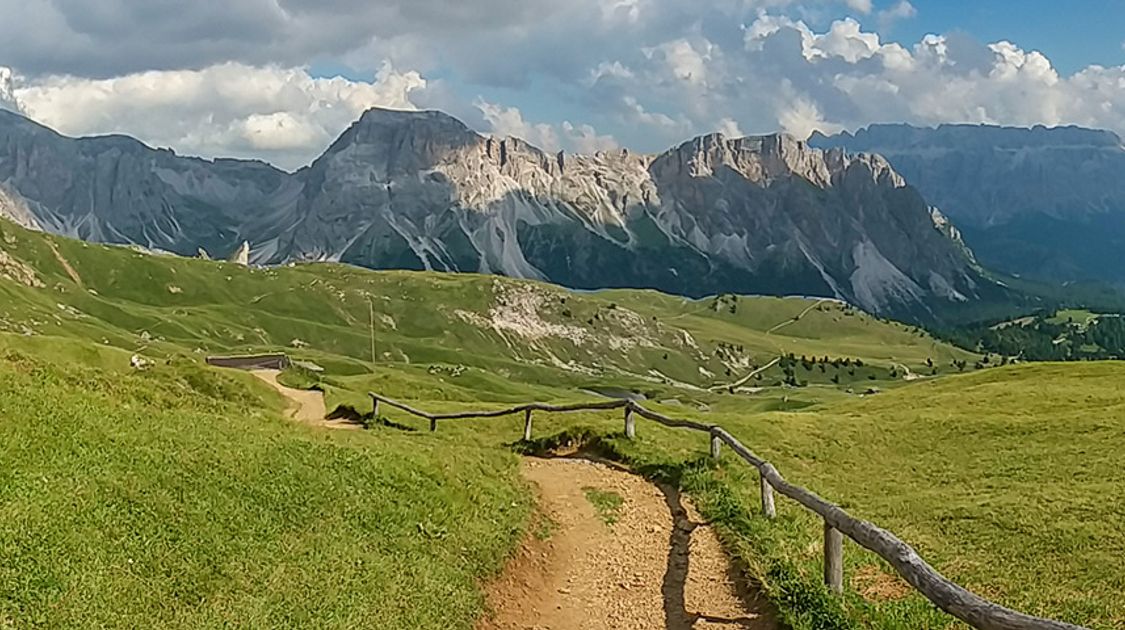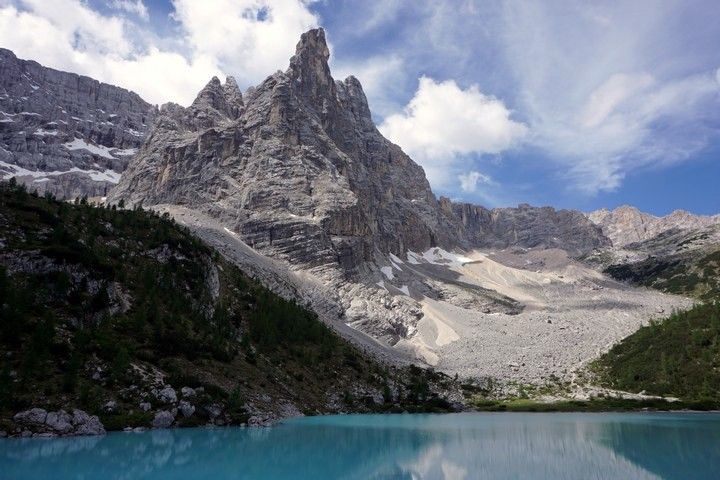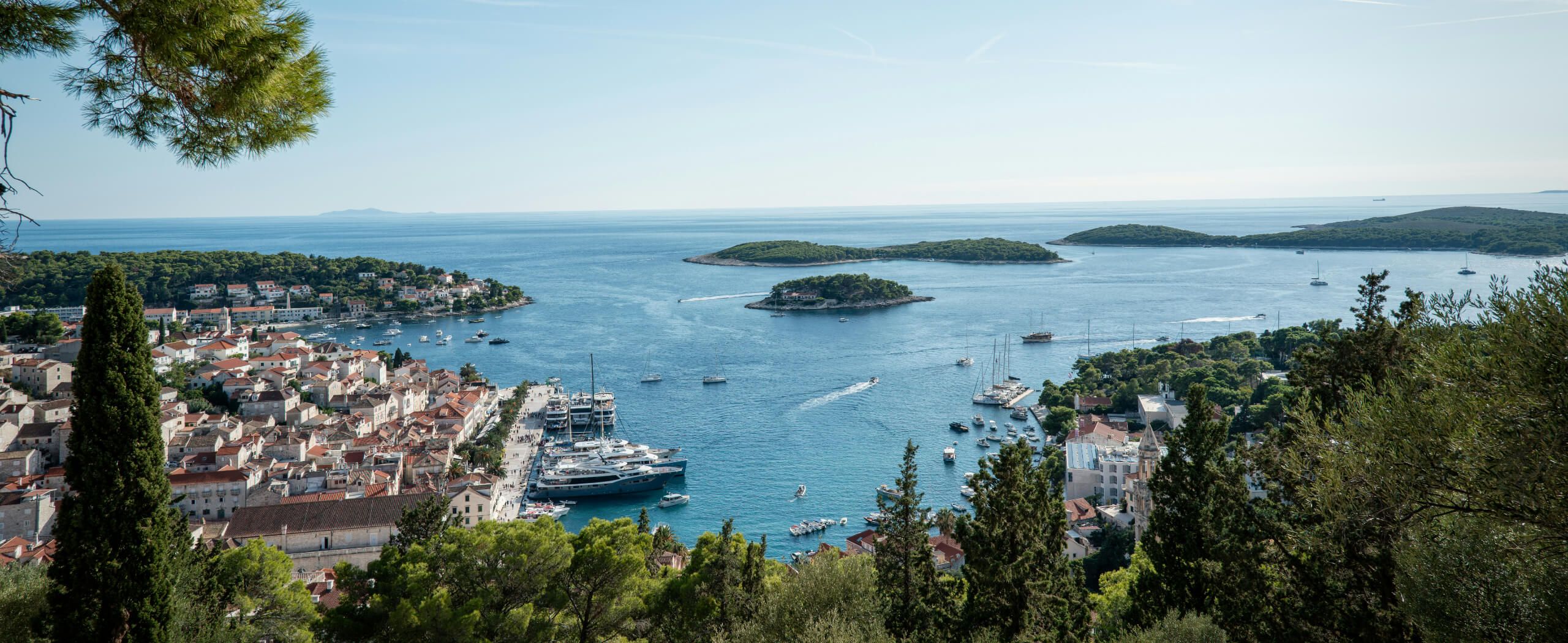

BlogTrip GuidesThe Ultimate Guide to the Italian Dolomites
The Ultimate Guide to the Italian Dolomites
Richard Campbell
Nov 4, 2025
The Italian Dolomites are one of those bucket-list places. Stunning mountains, great hiking, beautiful food and a vacation steeped in La Dolce Vita. A few days in the Dolomites is never enough. Below are our tips for planning your holiday in the Dolomites.
Etched high in the skyline of the northern Italian Alps, bounded by rolling green valleys, turquoise lakes, and spectacular glaciers, you’ll find the Italian Dolomites. This impressive mountain group is home to a number of sheer, towering peaks, including many that rise over 3,000m, with the highest being Marmolada, standing 3,343m above sea level.
Throughout centuries, the Dolomites, formed by pale dolomitic limestone, have eroded. Jagged peaks, sheer cliffs, massive rock faces and deep, narrow valleys are common throughout the Dolomite range, widely regarded as being one of the most spectacular mountain landscapes in the world.
Spanning 141,903 hectares, the Dolomites were named a UNESCO World Heritage Site in 2009 for both their beauty and earth-science value. The wide variety and high concentration of limestone formations in one area is unique to this mountain range and the exposed geography provides scientists and visitors alike a small glimpse of marine life in the Triassic period.
There are more than enough ways to explore the area. In the summer you can hike, climb, hang-glide or cycle. When the snow falls you can ski, snowboard, or try your hand at other winter sports. Since the first explorers set foot on the Dolomites in the mid-1800s, it has become a popular tourist destination – promising adventure and discovery around every corner.
The most important route in the area is the A22, the main north-south highway that connects Italy with Central Europe. This road connects you with the Austrian city of Innsbruck, as well as notable cities on the Italian side including Bressanone, Bolzano, Trento, and Rovereto. Another noteworthy highway is A27, which connects the region to the city of Venice.
2026 will be a banner year for the Dolomites, as the winter Olympics are coming, based partially at the stunning alpine town of Cortina d'Ampezzo.
Here we’ll take you through the basic overview of hiking in the Italian Dolomites - including how to get there, where to stay, where to eat, what to see and what to watch out for.

Lago del Sorapis on a hike in Italian Dolomites

Carezza Lake trail in Italian Dolomites is crossed by many wild streams
How to get to the Dolomites
You have several options for airports to consider when flying to the Dolomite region. The closest airports to the region are Venice Marco Polo (VCE) or the Treviso Airport (TSF). Venice Marco Polo offers service on a wide variety of airlines, to and from many destinations, including seasonal direct flights from North America. Treviso is a smaller airport near Venice that is primarily used by Ryanair, so budget flights are available to and from many cities across Europe.
You may also want to consider the Verona Villafranca Airport (VRN), though most flights here are seasonal. Slightly farther away, but possibly less expensive options are the Milan area airports: Milan Linate (LIN), Milan Malpensa (MPX), and Milan Bergamo Airport (BGO), which is another hub for Ryanair and other airlines seasonally.
Another option, especially if you’re planning to rent a car, is to fly to Munich Airport (MUC). It may save you money to rent your car in Germany rather than Italy, and though the drive is over 300 km, it is beautifully scenic and gives you the opportunity to explore the Tirolean region of Austria as well.
As always, explore the options from your city and remember that price is only one factor. Consider schedules that will work well without arriving exhausted, and what form of transportation you plan to use once you arrive. The cheapest option isn’t always the best.
BEST TIME TO VISIT THE DOLOMITES
There’s really never a bad time to visit the Dolomites, with each season bringing its own special benefits. During the winter season the spectacular peaks provide excellent terrain for skiing, snowboarding, snowshoeing and more! The region is home to one of the world’s top ski resorts, famously hosting the 1956 Winter Olympics in Cortina. The sun shines on average eight out of every ten days - more than any other range in the Alps. Did we mention the Christmas markets?
If you prefer to wait until the snow melts, the other seasons have lots to offer in the Dolomites. Once spring arrives the mountains shed their snowy layers and reveal the light color of the limestone once again. Hiking and cycling trails open up, and against the backdrop of wildflower-clad meadows and rolling green fields, the scenery is spectacular.
As summer rolls in all manner of adventuring routes - including trails, climbing and the via ferrata - are open, as well as the numerous rifugi (mountain huts) which provide a place to sleep along the hiking paths. There are also a number of music festivals during this time throughout the region, but it’s also the most crowded time of year!
In the fall, crowds begin to disperse, and you can be sure to have increased solitude to admire the wonderful landscape. As the larch trees turn to a stunning golden hue, the mountain air turns crisp and fresh.
Average monthly temperature and precipitation:

HOW TO GET AROUND the Italian Dolomites
Car Hire
The easiest and most convenient way to get around in the Dolomites is by private vehicle. With this option you have the flexibility to travel from place to place with ease, enjoying the spectacular landscape and scenery at your leisure. Car rentals are available at airports and in larger cities, but may be difficult to find in the rural mountain region. If you do rent a car, pay close attention to traffic signals as violations are recorded on video along the road and you might just receive a ticket in the mail. In addition, take extreme caution on winding mountain roads. Sudden road closures due to adverse weather conditions are common in the winter.
Dolomites Public Transport
Public transport in the Dolomites also runs from the larger cities – Verona, Venice, and Milan – to the alpine villages that provide access to the trails. To reach the most remote areas, you’ll need to find a bus, as trains mostly service the larger cities and towns. For more information about buses consult any of the following services: Dolomiti Bus, ATVO, Cortina Express, Trentino Transporti or Südtirol Mobile. For train information consult the TrenItalia website.

Viel del Pan trail in Italian Dolomites has a beautiful view of Marmolada Massif

Tre Cime trail in Italian Dolomites has stunning panorama all around
WHERE TO STAY IN THE DOLOMITES
If you’re looking where to stay in the Dolomites, you’re in luck. Accommodation in the Dolomites range from chic, classic options (renovated chalets, 19th-century hotels and stately castles) to the rustic rifugi (mountain huts) along the trails that are typically only open during the warmer months. Interspersed between these options, you’ll find a number of budget-friendly bed and breakfasts in the smaller villages. If you plan to go during the winter, you’ll most likely need to book a ski vacation as a package deal with the hotel included. During the high season (summer and winter) make sure to plan ahead and reserve your lodging early.
We suggest first deciding which area of the Dolomites you want to stay in and then searching for accommodation from there. Our favorite bases are Cortina d’Ampezzo, the Badia Valley, and the Gardena Valley, especially Ortisei.
Cortina d’Ampezzo
Cortina d’Ampezzo is in the heart of the southern Dolomitic Alps. The town swells from 7,000 to 40,000 in the winter months with the influx of mountain-crazed tourists. The town also hosted the 1956 Winter Olympics. That said, there are many great little villages scattered about this stunning region. Such a prestigious region has many luxurious hotels
Alta Badia
The Badia Valley, or Alta Badia,, has been carved by the Gran Ega river in South Tyrol. Badia, La Villas, and Corvara are some of the largest communes in the Badia Valley. It’s also important to note that the citizens in this valley speak the Ladin language (not Latin). Ladin is a romance language that is only really spoken in five valleys.
Val Gardena
Val Gardena is another Ladin speaking valley. The main river running through the valley is the Derjon, and the main villages are Ortisei, Selva, and Santa Cristina. The valley is known for skiing, rock climbing, hiking, and charming wood carvings.
Mountain Huts (Rifugi) in the Italian Dolomites
For those looking for a pure hiking experience, the rifugi (mountain huts) are the way to go. Most huts along the hiking trails are run by the Club Alpino Italiano. Most huts have their own websites where you can find more details and reservation information. Typically, reservations can be made via email or telephone. There is no tent camping allowed in the region.

Sassolungo trail in Dolomites is surrounded by spruces forest

Trail of Lago di Braies passes through the boathouse
BEST RESTAURANTS IN THE DOLOMITES
As with accommodation, the Dolomites offer visitors a vast selection of eating options. Don’t expect pure pizza and pasta here, however – it’s clear from the first menu glance that the Austrian influence is firmly cemented in the culture and restaurants. Expect a mix of Italian and Austro-Germanic dishes such as a variety of sausages, spätzle (similar to pasta but much thicker in texture), as well as fresh meats, cheeses and produce from neighboring farms. You may also find that most restaurants either produce their own crops and livestock or work closely with food producers in the area.
Our favorite meal in all of the Dolomites was quite special. Perched on the top of Mount Lagazuoi, in the Rifugio Lagazuoi, we found the most perfect strudel in the world. As we looked across the mountaintops, we savored a combination of strudel, espresso, and the breathtaking location. We cannot recommend it enough. It is bucket-list-level strudel. You can reach the Rifugio Lagazuoi via the Funivia Cable Car from the Falzarego Pass.

Alpe de Sennes trail has beautiful views of Dolomites

Seceda views from Circuit of Odle trail in Dolomites
THINGS TO DO IN THE ITALIAN DOLOMITES
Hiking in the Dolomites
It's not all about hiking in the Dolomites. The Dolomites offer so much to do, that it’s easy to spend a season here and still explore new things all the time. While the landscape is what draws most visitors, the Dolomites also offer a wide variety of activities - both indoors and out. It’s the kind of place you go to for a filling meal after a long day of hiking, and is. It’s loads of fun.
You can also find a variety of epic trekking tours in the Dolomites. Some of the most popular are the famous Alta Via 1 trekking tour, which you can also do more comfortably in the Alta Via Trek in Hotels Tour. Walking in Val Badia is another great hiking tour. Nearby trekking in Val Gardena is also beautiful. Perhaps the most epic two places to visit are connected on this Lago di Braies to Tre Cime Self-Guided hiking tour. For those that love mountain huts, the Italian Rifugi are spectacular on the Hut-to-Hut in the Dolomites tour.
Winter in the Dolomites
Obviously in winter there is incredible skiing throughout the region. Some of the most legendary ski areas on earth can be found in the Dolomites. We are particularly fond of skiing around Cortina as well as in the Val Gardena Valley. The scenery in the Dolomites seems more epic than other places in the Alps. Winter also sees options for snow-shoeing in the Dolomites and cross-country skiing in the Dolomites, however the season for both is much shorter in 2026 due to the winter olympics. You can even find winter hiking in the Dolomites!
Cycling in the Dolomites
Summer is also great for cycling in the Dolomites. The roads are also full of road cyclists, trying to get over the high, beautiful passes. We recommend all of these, although road bikers will need to check for traffic, as the roads are narrow and crowded. Some of the most popular tours are Cycling the Dolomites to Lake Garda, or Cycling the Dolomites to Venice. There is also the classic self-guided Dolomites Cycling Tour.
Other things to do in the Dolomites
The Museo Archeologico Dell'alto Adige in Bolzano should not be missed. This archeological museum features Ötzi, a more than 5,300-year-old iceman discovered deep in ice and snow nearly 30 years ago. The mummy, his clothing and equipment were all well preserved in the fierce cold and are now all on display at the museum.
And not to worry, if your feet need a rest you can still explore the awe-inspiring landscape - from a cable car, of course! Routes run from many of the main areas within the Dolomites. In Bolzano, for example, you can find a number of cable car routes. In addition, if you’ve got a private car at your disposal, we recommend taking a drive on the Great Dolomites Road. Connecting Bozen and Bolzano, this route crosses through a number of scenic points including Falzarego, Pordoi and Karerpass.

Nuvolau trail in Dolomites takes you through beautiful overlooks to Cinque Torri and Rifugio Scoiattoli

Visiting Dolomites is a must when planning your trip to Italy
DANGERS WHEN HIKING IN THE ITALIAN DOLOMITES
- Weather can change quickly in the mountains. Watch out for lighting storms and snow.
- Pay attention on trails, the cliffs can be very steep, and people have fallen off before.
- Sometimes it feels like driving around the Dolomites is the most dangerous part. With stunning, narrow roads surrounded by some of the best mountain scenery on earth, many people end up not paying enough attention.
INTERESTING FACTS ABOUT THE DOLOMITES
- Cell phone reception is not guaranteed, so make sure you have downloaded your hiking route description before you leave cell phone service
- Make sure to book ahead during the high season.
- It can get very pricey - even for the most rustic accommodation.
- Most staff in tourist areas such as lodging and restaurants will speak English, but Italian and German are the most common languages.
- Make sure you check seasonal availability ahead of time because many places may be closed in the winter.
- The pronunciation of Dolomites depends on whether you want to say it in English, or pass for a local! In English, Dolomites is pronounced DOH-loh-mytes, but in Italian it’s pronounced doh-loh-MEE-tee.
- When hiking in the Dolomites, it’s important to come well prepared for all kinds of weather. Even in summer, weather in the mountains can be unpredictable, so you’ll need to bring plenty of lightweight layers, waterproofs, and a pair of sturdy hiking boots. If you’re hiking in winter or the shoulder seasons of spring and autumn, you may encounter snow, in which case you will need warmer clothing. Make sure to buy good quality, durable hiking gear, with some thermal layers and a windproof coat.
- On the whole, Italy is a very safe tourist destination, attracting millions of visitors every year. Mostly, the risks are centred on petty crime, and you’ll need to be aware of pickpockets in towns and cities. as on any trip, you’ll need to stay aware and vigilant, wherever you go. The local inhabitants in the Dolomites are very welcoming to visitors, and the main dangers here relate to accidents out on the trail.
- The splendor of the Dolomites can be seen from a large distance, even as far as the maritime city of Venice. You’ll need to catch them on a clear day, but it’s sometimes even possible to see the snow-capped peaks from the top of the Bell Tower in the Piazza San Marco!
Recent stories

Destinations
Everything You Need to Know About Sailing Tours in Croatia
Have you ever dreamed of a sailing tour in Croatia, but weren’t quite sure where to start?
Nadine Gravis
Dec 3, 2025

Destinations
10 Best Mediterranean Treks for 2026
The Mediterranean boasts some of the world's most beautiful, bucket-list countries: France, Italy, Croatia, Bosnia and Herzegovina, Cyprus, Greece, Turkey, Israel, Egypt, and Morocco, to name a few.
Kelsey Krahn
Dec 2, 2025

Destinations
The 10 Best Long Distance Walks in the UK for 2026
The UK is one of the most accessible and scenic countries to explore on a walking holiday.
Mallory Kirzinger
Dec 2, 2025